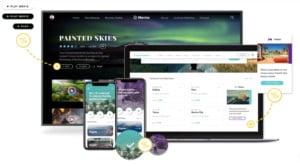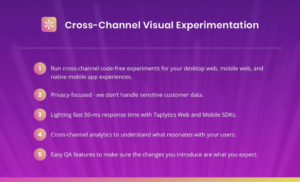Discover How to Cross-Team Brainstorm Through No Code

Taking a product from idea all the way to release requires input from team members throughout your organization. Being able to collaborate effectively across these teams is the key to making product development as seamless and valuable as possible.
Then why are 75% percent of cross-team collaboration efforts dysfunctional, according to Behnam Tabrizi, an organizational leadership researcher at Stanford? Because navigating the various pitfalls and potential issues that arise when working cross-functionally isn’t always easy. It requires a culture of open and honest communication, as well as a strong strategic approach to creating value for customers.
Fostering cross-team collaboration not only helps increase productivity, but it also frees up resources for your team and makes innovation easier throughout the development process. And a critical piece of collaborating well as a team is being able to experiment and test your hypotheses, which is where no-code experimentation can help.
When your team understands how they work together and has the tools and autonomy to refine these processes as they move forward, that makes achieving your overarching goals simple.
No-Code Experimentation Frees up Resources for Your Team
No-code experimentation facilitates cross-team collaboration because it removes one of the biggest barriers to product development for companies that lack enterprise-grade budgets: finite engineering and development resources. When your product and marketing teams can easily run tests on their own, it ensures that developers stay focused on adding value through their day-to-day tasks.
Previously, only companies with the resources to build in-house experimentation tools could quickly deploy tests and learn what successfully engaged users or led to better conversion rates.
Thanks to no-code testing tools like Taplytics’ cross-channel A/B testing, every team within your organization can experiment collaboratively without the need for development resources. This allows product teams to collaborate with their marketing counterparts to deploy tests across websites, apps, and other connected-devices. And it provides actionable data they can use to inform product decisions in the future.
Being able to test autonomously frees up product, sales, and marketing teams to focus on their individual goals as well. Instead relying on engineering and product teams to implement and execute tests, they can increase experiment velocity and any learnings to analyze results to better understand how those experiments increased conversions or reduced user churn.
“The best approach will vary from one company to the next, but at its heart lies the challenge of transcending functional boundaries—a difficult achievement in itself,” said Paul Leinwand and Cesare Mainardi in their book, Strategy That Works, an analysis that included studying cross-team collaboration. “This means centralizing and systematizing activity throughout your company while still fostering participation and experimentation.”
No-code experimentation makes it possible for product, marketing, and engineering teams to systemize experimentation and build a culture of collaboration.
Cross-Team Collaboration Simplifies Continual Iteration
Combining no-code experimentation with a focus on cross-team collaboration helps you work through the product development process faster without sacrificing quality. Teams that have a clear sense of how they work together will grow and scale more effectively—refining processes and workflows to deliver the most value possible to your customers.
They’re able to do all of this because each member of your organization, from the product managers defining the strategy to the marketers crafting messaging campaigns, knows how to work together. They understand the underlying goals and desired outcomes of every release, as well as the best way to communicate your product’s value to potential customers.
Great cross-functional teams also understand that continual iteration and release are built on top of a base of solid data—data that informs decisions and guides experiments. And they know how to run these experiments autonomously. This not only frees up developer resources to focus on building new and exciting products for customers, but it also helps each member of the team engage with their work on a deeper level.
But improving your teams’ ability to iterate through the product development process is just part of the equation. Effective cross-team collaboration cuts down on total development time and helps you generate value from each release faster.
No-code experimentation gives your team the ability to deploy multiple experiments simultaneously, which avoids the time-consuming process of deploying experiments in a linear or successive fashion. When you combine this with the ability to test across multiple channels, it ensures that each stage of the experimentation process is as streamlined as possible.
The ability to experiment faster across each of these channels makes collecting data and proving hypotheses easier, which helps your team create a higher converting product, while improving the overall customer experience with each test.
Let’s say you have an idea for a new user onboarding flow, one that originates from within your marketing team. That team documents their idea and the potential impact they think it will have on the user experience and ships those details over to the product team.
The product team mocks up the new experience in wireframes and fleshes out potential designs and requisite features. Once the idea is integrated into the overarching product strategy, they define the requirements and send the project to engineering for active development. Each stage of the product development life cycle takes time and resources to complete, all of which are factored into the total time-to-value (TTV) for your project.
When you’re able to cut down on the time it takes to create value for your business, that helps build a clearer picture of the impact your team has on the company’s bottom line. Using that knowledge, you can create more effective revenue and resource projects for the future.
Cross-Team Collaboration Drives Innovation
One of the biggest benefits of cross-team collaboration is that teams from different disciplines, backgrounds, and skillsets have the ability to work through innovative new ideas together.
“Cross-functional teams provide the basis for a creative mix of people with different backgrounds, orientations, cultural values, and styles,” writes Glenn M. Parker, author of Cross-Functional Teams. “Although this diversity can be difficult to manage, the possibilities for bright new ideas and innovations to bubble up are great.”
To facilitate this kind of bottom-up innovation, try to foster connections between every member of your team. To do that, you need to have a company culture that’s built on trust and a shared understanding. Encouraging cross-team collaboration ensures that each member of the team feels like their opinions are not only valid but that they’re heard as well. Even the kernel of an idea can become a valuable and engaging product, given that it’s visible to the entire team.
No-code experimentation further helps drive innovation and new ideas by enabling teams to quickly apply their hypotheses to experiments. That means they can validate their assumptions directly—bringing more fleshed out and interesting ideas to the rest of the team. When collaborating teams can quickly see conclusive results to experiments, that path to innovation is more straightforward, as winning ideas can be validated and replicated with data rather than guesswork.
No-Code Experimentation Makes Collaboration Easy
No-code experimentation gives organizations of all sizes a way to improve cross-team collaboration. It offers smaller organizations an effective shortcut that makes it possible for cross-functional teams to learn, engage, and innovate more quickly without the need for commitments of developer resources.
When cross-functional teams deploy rapid testing via no-code experimentation, every team, not just those with the budget and resources of an enterprise-sized business, can optimize experiences for their users.


